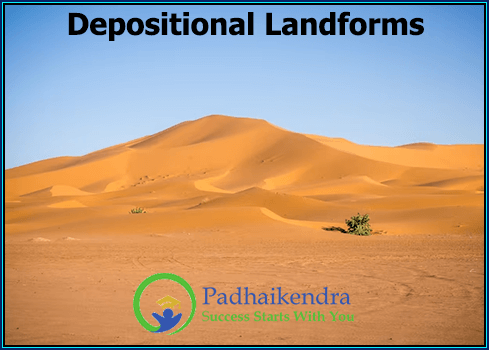Depositional landforms are created by the deposition of sediment carried by water, wind, or ice. As these natural forces slow down or come to a stop, the sediment is deposited in a new location, gradually building up over time to form new landforms. Here are some examples of depositional landforms:
- Deltas: Deltas are formed where a river meets the sea, and the sediment carried by the river is deposited at the mouth of the river. The sediment builds up over time, creating a fan-shaped landform with numerous channels that branch out into the sea. Some of the largest deltas in the world include the Nile Delta in Egypt and the Ganges-Brahmaputra Delta in India and Bangladesh.
- Beaches: Beaches are depositional landforms that form along the shoreline of oceans and lakes. They are created by the movement of sediment by waves and currents, and they can be made up of sand, gravel, or rock. Beaches are popular destinations for recreation and tourism around the world.
- Sand Dunes: Sand dunes are formed by wind-blown sediment, often in arid or desert regions. As the wind blows, it picks up loose sediment and deposits it in a new location, forming a mound or hill of sand. Sand dunes can be found in a variety of shapes and sizes, from small ripples to towering dunes several hundred feet high. Some of the most famous sand dunes in the world are found in the Sahara Desert and the Great Sand Dunes National Park in the United States.
- Alluvial Fans: Alluvial fans are fan-shaped deposits of sediment that form at the base of mountains or hills. They are created by the erosion of sediment by streams or rivers, which is then deposited at the base of the slope. Alluvial fans can be found in a variety of shapes and sizes, and they are often used for agriculture in dry regions.
- Moraines: Moraines are depositional landforms created by glaciers. As glaciers move down a valley, they pick up rocks, boulders, and other sediment, which is then deposited at the edge of the glacier or left behind as the glacier recedes. Moraines can be found in a variety of shapes and sizes, from small ridges to large hills and valleys. They are often used as indicators of past glacial activity.
Overall, depositional landforms provide a fascinating insight into the processes that shape the Earth’s surface over time. They offer a reminder of the constant evolution of our planet and the important role that natural forces play in shaping our world.





